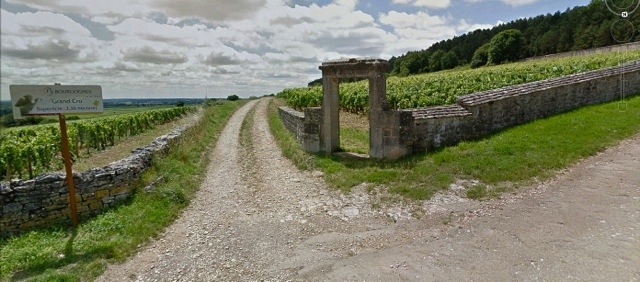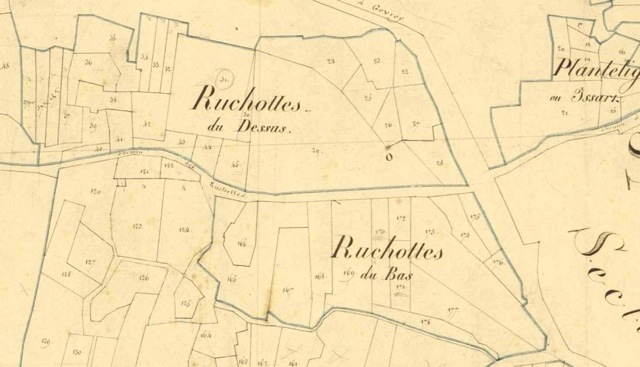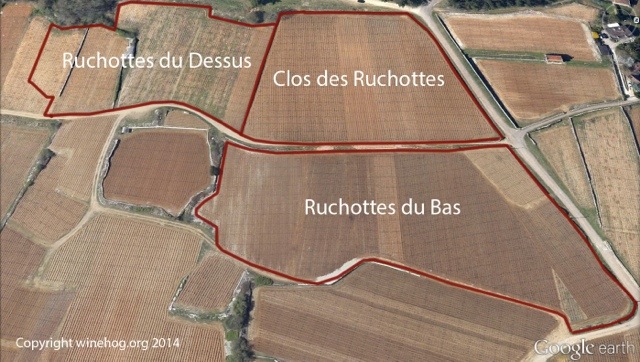Ruchottes-Chambertin is in my view one of the most interesting terroirs in Gevrey-Chambertin. The vineyard is small yet it includes two climates and one Clos and monopole – nothing is ever simple in Burgundy.
While Ruchottes-Chambertin isn’t quite in the same league as Le Chambertin and Clos des Beze, its certainly one of the most interesting of the other grand crus – with its refined and playful minerality.
The Clos des Ruchottes from Rousseau is the most famous wine from this vineyard – but other prominent producers like Domaine George Roumier and Domaine Mugneret-Gibourg are also making fine wines on this special terroir.
The terroirs called Ruchottes-Chambertin
Ruchottes-Chambertin is a terroir know for its minerality – and the name Ruchottes actually comes from the french word rochers – which translates into rocks or small rocks.
The vineyard include two official climates – Ruchottes du Bas – the lower part of the vineyard, and Ruchottes du Dessus the top part of the vineyard – see the cadastre map from 1828 below.
The structure with two subclimates exists even in todays cadastre, but the plots internally in the two sections have changed.
Inside the climate Ruchottes du Dessus we find the “third” climate Clos des Ruchottes – a monopole located in the northern part of the vineyard – and now owned by Domaine Armand Rousseau. Clos des Ruchottes is not mentioned on the cadastre maps – and is not a separate climate in that sense. I don’t know when the wall enclosing Clos des Ruchottes was established – but it the plots on the cadaste map from 1828 indicate that the Clos could have been established already at that time.
The early history of Ruchottes-Chambertin
As mentioned above Ruchottes-Chambertin include two climates – Ruchottes du Dessus and Ruchottes du Bas. Lavalle1 mention both in his book from 1855 – but they are mentioned separately.Ruchottes du Dessus is mentioned as Premier Cuvee de finage while Ruchottes du Bas is classified as Deuxime Cuvee de finage.
This is not unusual in the Lavalle classification – where a vineyard like Mazy-Chambertin is rated in the same way – i.e. the top part is Premier Cuvee and the bottom part is only Deuxime Cuvee.
The owners in 1855 were the following Ruchottes du Dessus (2 ha): Delachére and Collot. On Ruchottes du Bas (1.4 ha): he mention de Grésigny, Delachére, Marion and Heritieres Belot.The total area was according to Lavalle 3.4 ha – comparable with the current area of 3.38 ha4.
Danguy and Aubertin2 1892 mention three owners on the top part of the vineyard – Tisserandot-Girod and Tisserando-Grimaut and last but not least Thomas-Bassot as the only owner on Clos des Ruchottes. So the name Clos des Ruchottes was established before 1892.
Maison Thomas-Bassot was a large negociant house in Nuits-Saint-Georges that was founded in 1850 by Auguste Thomas – they soon after began to acquire vineyards, and they bought both the Clos des Ruchottes vineyard and some other plots in Ruchotte du Bas and Ruchottes du Dessus. Danguy and Aubertin mention the following owners on Ruchottes du Bas: Boinet-Foulet, Fricot-Roblot, de Morot de Gresigny, Poillot Pere and Thomas-Bassot.
In 1920 Rodier3 mention the following owners on Ruchottes-Chambertin – Grillet-Bourgeot, Magnien-Flenrot and Thomas-Bassot.
The Thomas Bassot era
Maison Thomas-Bassot was the principal owner on Ruchottes-Chambertin in more than 100 years. It appears that Thomas-Bassot produced two wines from Ruchottes Chambertin – a wine from Clos des Ruchottes and a “generic” Ruchottes from the other plots.
In 1976 Maison Thomas-Bassot was sold of the to Jean-Claude Boisset4 – and in connection with this deal some of the vineyards were sold off – including the holdings in Ruchottes-Chambertin.
Domaine Armand Rousseau was very interested in the holdings in Ruchottes-Chambertin – but Charles Rousseau was not able to afford all the plots and contacted his fellow vignerons Roumier and Dr. Georges Mugneret, and they agreed to split the Thomas-Bassot holdings between them.
Domaine Rousseau got Clos des Ruchottes, Dr. Georges Mugneret (the current Mugneret-Gibourg) acquired the plots in the Ruchottes du Bas and lastly Roumier got the plots in Ruchottes du Dessus.
The Roumier family were however not able to finance the deal themselves, and the plots were therefore was sold to a wealthy collector from Rouen – Michel Bonnefond. Roumier made a share-cropping agreement with Bonnefond and makes the wine from Bonnefonds plots on Ruchottes-Chambertin 1 + 6.
The current owners on
The current ownership structure is to a large degree defined by the Thomas-Bassot deal in 1976 – with Domaine Rousseau as the largest owner.
Current owners on Ruchottes Chambertin4 + 6:
- Armand Rousseau – 1.1 ha – Clos des Ruchottes
- Mugneret-Gibourg – 0.67 ha – Ruchottes du Bas
- Michel Bonnefond – 0.54 ha – Ruchottes du Dessus
- Suzanne Thomas-Collignon/Frederic Esmonin – 0.50 ha – Ruchottes du Bas
- Francois Trapet – 0.21 ha – Ruchottes du Dessus
- Henri Magnien – 0.16 ha – Ruchottes du Bas and Ruchottes du Dessus
- Chateau de Marsanney – 0.10 ha – Ruchottes du Bas
- Marchand-Grillot – 0.08 ha – Ruchottes du Bas
Some sources mention Frederic Esmonin as share-cropper on the plot owned by Suzanne Thomas-Collignon, while Jasper Morris6 refer to Esmonin as owner of the plot. Nevertheless he is making the wine from this plot. Philippe Pacalet is making his Ruchotte Chambertin on the plot owned by Francois Trapet – and its a lovely Ruchottes in my view.
On the map below one can see the detailed ownership on Rucottes Chambertin.
You need to login to read the rest of this article. If you are not a subscriber, use the subscribe function and sign-up.




 - A true vin d’émotion – a Burgundy of passion
- A true vin d’émotion – a Burgundy of passion - A truly hedonistic wine – lively and enjoyable
- A truly hedonistic wine – lively and enjoyable - A vivacious wine for pure indulgance
- A vivacious wine for pure indulgance - A potential vin d´émotion - frais et léger
- A potential vin d´émotion - frais et léger